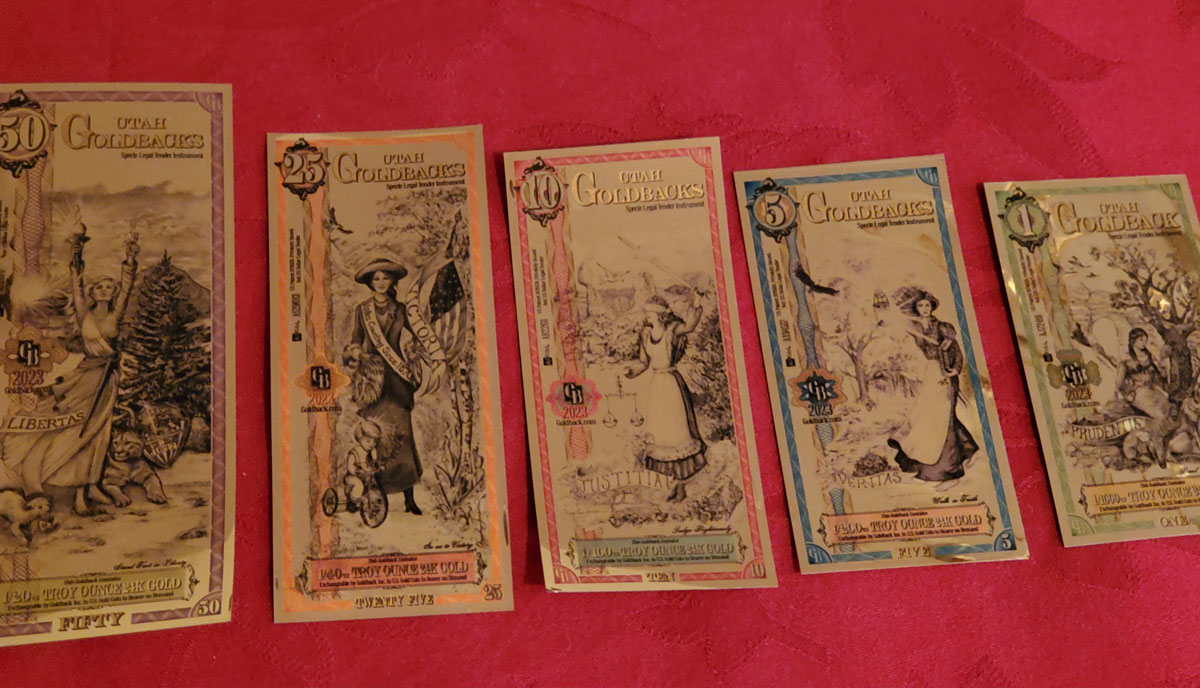(Want to meet me in person and attend my live lectures? Please join me at the White Coat Investor’s Financial Literacy and Wellness Conference, February 5-8, 2024, in Orlando, Florida. I will be giving two lectures at this amazing conference where I have been a speaker multiple times in the past. If you have some of my books, bring them with you to get them autographed at my book signing event or catch me in the hall. There will also be books available to purchase on site. A few of you can even have dinner with me! Hope to see you there.)
I am not a fan of investing in gold. In fact, gold is not an investment at all, it is a commodity. When you trade in commodities, you are speculating, not investing, and that is far too risky for my blood. But there are those who feel they simply MUST own gold in case the US economy tanks just like what happened to Argentina in 1998, Zimbabwe in 2000, and Venezuela in 2013.
But if our economy tanks, will having gold to trade do anyone any good? No one will have money to buy the gold. People would likely be more interested in trading services or goods than trading their valuable commodity for your gold (which is not edible). In this situation a loaf of bread will be very valuable. I’m not sure people will think a hunk of gold will be worth a trade. I think I would rather invest in bullets to prepare for such a crash.
I was recently introduced to a new way of owning gold. Goldbacks, seen in this articles picture on my website, are way easier to trade for goods than any other form of gold. They come in several denominations, are easy to transport, and would work well in the place of money. But are they good enough to use in place of dollars?
Goldbacks are a clever idea that is most appealing to “preppers.” Preppers are those who work to reduce their dependence on governmental infrastructure. They stockpile goods (food, water, and tools) and learn survival skills so they can be more independent in the event a catastrophe forces them to become self-sufficient, “off the grid.” They are also fond of gold as a means for making transactions in the event of a monetary collapse.
The main problem with gold is it tends to be either in the form of a bar, or a piece of jewelry. Money, on the other hand, is held in multiple denominations and is an easy form of trade. It is very hard to make change for a bar of gold, or to only scrape off a little bit of gold for a transaction.
One solution for this problem is smaller bars that are made like a Hershey chocolate bar so one can break off small pieces that will be a uniform size, such as one gram. There are 31.1 grams in a troy ounce of gold. (Troy ounces are used to measure precious metals and should not be confused with a standard ounce) The price of gold when I wrote this was $2,057.38 per troy ounce. That makes a gram of gold worth $66.15, which is the smallest trading commodity of gold bars. However, sixty-six dollars and fifteen cents is too large to be the smallest denomination. So along came Goldbacks, which come in various sizes as small as 1/1000th of an ounce, which is worth about $4, and have the familiar shape of currency.
Goldbacks are made of 24k gold shaped into flat pieces that look like currency. Each piece is then coated with a clear polymer to hold it together. It comes in denominations of 1, 5, 10, 25, and 50. Each denomination represents the corresponding number of 1/1000th of an ounce of gold. For example, the 10 Goldback is 10/1000th of an ounce of gold. It resembles paper money and can be spent the same way.
It is minted by Valaurum, a private mint in a secret location in Oregon, and is not part of any regulated monetary system. It is simply gold made into a useable form for trading. They are currently used in five states: Utah, Nevada, New Hampshire, Wyoming and South Dakota. Each of these states have laws in place that let people use gold as legal tender. They are not backed by any state or federal government. They are a private monetary instrument.
Each Goldback is a beautiful piece of art. Consequently, they are also purchased by collectors, like the state quarters that were introduced in 1999.
Advantages of using Goldbacks
Goldbacks are not just backed by a true commodity, they are the commodity. When you have a Goldback, you are holding gold in your hands. Dollars are valued by policy. At one time the US Dollar was backed by gold, but that came to an end in 1933.
Goldbacks come in several denominations, including small ones, so it is easy to trade and make change.
Transactions can be private since Goldbacks cannot be deposited into a bank.
These “bills” are easily carried in a wallet.
This is an easy way to buy gold in small amounts for those who can’t afford a gold bar.
Makes a great and exciting gift.
Disadvantages of Goldbacks
They are new so few places use them for trade. Businesses in the five states supporting Goldbacks have signs stating they take Goldbacks. In those businesses they can be used like money. One Goldback is the equivalent of $4. For the rest of the country, they are a collector’s item for now.
There is no FDIC insurance. To deposit these in a bank, one either puts them in a safe deposit box or converts them to dollars first.
They are not actual cash, so they are less liquid than cash.
There is only about $20M in circulation.
Biggest disadvantage is the markup
Currently Goldbacks are expensive to make. Thus, the markup is just short of 100%. So one Goldback, which contains about $2 worth of gold costs just shy of $4. But once owned, trades for $4.
I did a price comparison of different forms of gold.
The spot price of gold is $2,057.38 per troy ounce.
Buying a 1K (2.2 pounds) bar of gold costs $67,426.32. This equates to $2,096.98/oz. which comes to about a 1% markup.
Buying a 50g bar of gold that is stamped to break easily into 1g bits, costs $3,519.69 which equates to $2,190.22/oz. Which is a 6.5% markup.
Buying one of each denomination of a New Hampshire Goldback set, which is 91/1000th of an ounce, costs $348.53. This price is much more affordable than the other options, but works out to $3,830.34/oz, an 86% markup.
The high markup is said to be because of the expense of making the Goldbacks. They are stamped thin to a precise size, covered with beautiful artwork, and coated with a polymer. They are also exchangeable. If the polymer coating on a Goldback begins to come apart, it can be traded in for a new one, just like a worn-out dollar bill.
So, if you really need to have some gold as an investment, buy a gold bar which has the smallest markup in price.
But, if you want to own gold and don’t have much money, or you want to give your grandchild a cool gift of gold, the small denominations provided by Goldbacks are a nice choice.
There is a premium to pay for gold to be made into a form that is easy to trade. Is that premium worth the price? I don’t know. At this point I see them as more of a novelty item than a currency option.
Even with the markup, they are still a better deal than cryptocurrency, which has a value determined by smoke and mirrors. Worse case with the Goldbacks, you can melt them down and sell the gold. Worse case with crypto, your investment becomes the value of the smoke used in the smoke and mirror valuation method.






There is a new Android Goldback Calculator that makes it simple to calculate a purchase in Goldbacks and check the current value of your Goldbacks.
There may be a high upfront cost, but once you have bought them they increase with the value of gold. Now Goldbacks are worth well over $5 and there is even a new state announced. Florida will soon have Goldbacks.
Well it’s for sure that one day we’re going to be buying with gold and silver and it is for sure that five states right now are accepting this kind of currency and they will be more to follow and it is for sure that it has gold on it so is it more than just a collector’s item yes
Terry, your ability to predict the future is not likely any better than anyone else’s. I would be more careful about trying to say what will “for sure” happen in the future.
Gold is simply no good for survival or economy crash.if people are starving and business are broke who is gonna buy your gold or trade it for food .how foolish can we be .I’m sitting on sack of gold other people have basements of food lol
Who wants my gold lol nobody ..! Save and buy gold to cash in when world is still prospering than you will increase your investment but not for survival.
Unless you know when the world collapse you better cash gold in today tomorrow it maybe loaf bread or box rice has more value
Gold is a store of value. Not an investment.
A house in the 1930’s cost on average $4000. The equivalent in gold was 200 oz @ $50 an oz. If you saved your $4000 from 1930 until now you would be able to buy a crappy used car. But, if you saved your 200 oz gold you would have over $400,000 worth of gold to buy a house which is the average cost of a house today.
Think of gold as a time travel value commodity.
It is not fair to compare anything to putting the $4,000 in a jar in the ground to spend 94 years later. What your comparison shows is that putting the $4,000 in an interest-bearing savings account would be about the same return as putting it in gold. But in the Savings account the value would steadily climb. As gold the value would fluctuate. The better comparison is what would have happened to the $4,000 if you put it in the stock market. If during those 94 years you had an average return of only 8%, the $4,000 would now be worth over $7,000,000. More than 17x what it would be worth if you bought gold with it and held on for 94 years.